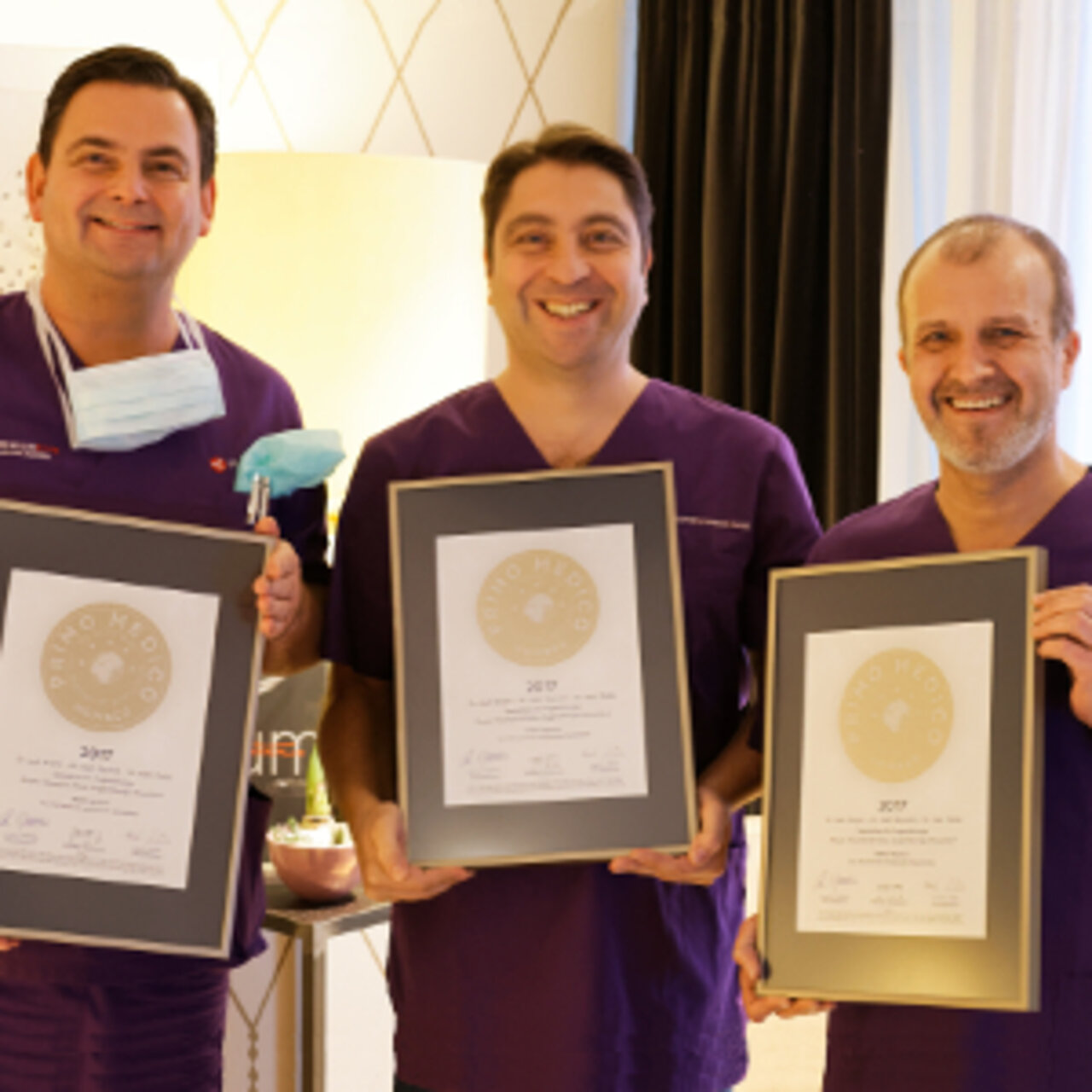Specialists in Diabetic Retinopathy
6 Specialists found
Information About the Field of Diabetic Retinopathy
What Is Diabetic Retinopathy?
Elevated sugar concentrations in the blood over long period damage the blood vessels, including the small vessels of the retina. The sugar alters and destroys the walls of the small vessels, causing them to become more permeable or burst. Damage to the retina results from bleeding, fluid accumulation, and new blood vessel formation.
About 5 percent of the population in Germany has diabetes. More than 20 percent of them suffer from diabetic retinopathy. The number of patients with type 2 diabetes increases due to a diet rich in carbohydrates and fats. Therefore, diabetic retinopathy is also gaining in importance. It is the most common cause of blindness in people aged 20 to 65 years in Europe and North America.
How Does Diabetic Retinopathy Develop?
Diabetic retinopathy results from disease of the retina's tiny blood vessels (microangiopathy). Increased sugar concentrations in the blood damage the retina's tiny blood vessels, making them more porous and fragile. As a result, fluid leaks out of the porous vessels.
With the fluid, fat and protein also escape from the vessels and are deposited in the retina. If small vessels burst, bleeding into the retina occurs. Deposits thicken and harden the damaged vessel walls (vascular sclerosis), which causes the vessels to narrow. As a result, less blood flows through the small vessels of the retina, which is then supplied with less oxygen. The thickened walls can even completely close the smallest vessels, the capillaries. The retina tries to form new vessels to compensate for the lack of oxygen supply. To do this, it produces growth factors (VEGF, vascular endothelial growth factor) that stimulate the formation of new vessels.
The new vessels originate from the small veins, the venules, of the retina and grow into the retina and vitreous body in a fan shape. These newly formed vessels are more fragile than normal blood vessels. As a result, they burst quickly, and severe bleeding into the vitreous can occur. The ingrowth of the vessels into the vitreous also creates a pull on the retina. This pull can detach the retina from its support, the choroid.
One complication of diabetic retinopathy is macular edema. The fluid that has leaked from permeable vessels collects in the central area of the retina, the macula, causing this area to swell.
Another problem can occur when VEGF enters the anterior eye segment with aqueous humor and stimulates new vessel formation in the iris. The newly formed vessels can close the chamber angle. The aqueous humor can then no longer drain, and secondary glaucoma develops.
How Do Visual Disturbances in Diabetes Manifest?
Initially, the patient hardly notices any deterioration in vision. It is only when the disease progresses those visual disturbances are noticed. This can reduce vision, distorted vision, or blind spots. The perception of flashes of light, black spots, and shadows can also be symptoms of retinal disease.
Macular edema can suddenly affect vision severely because the macula is the central area of the retina and the area of sharpest vision. Vision deterioration ranges from the reduced reading ability to extensive blindness. Vitreous hemorrhage also causes acute deterioration of vision. The patient sees blurred as if through a haze. The patient may go blind due to retinal detachment in the worst case.
Stages of Diabetic Retinopathy
Diabetic retinopathy is classified into the following stages:
- Mild non-proliferative diabetic retinopathy: the patient usually has no visual disturbances. On examination, the ophthalmologist notices slight changes in the retina. These may be slight bulges of the small blood vessels (microaneurysms), small punctate hemorrhages, and fatty deposits in the retina. The changes are reversible at this stage.
- Severe non-proliferative diabetic retinopathy: the changes in the retina are apparent. The typical findings on eye examination are multiple hemorrhages in the retina, blurred whitish-yellow spots, thickening of small veins, vascular changes, and retinal areas without a vascular supply. No newly formed vessels are visible yet. The patient may perceive visual disturbances, mainly if the changes occur in the macular region. This form develops into the proliferative form within a year in about half of the cases.
- Proliferative diabetic retinopathy: newly formed vessels are added to the existing changes. This can cause complications in the form of vitreous hemorrhage and retinal detachment. Multiple hemorrhages into the vitreous usually cannot be reversed. The proliferative form is more common in type 1 diabetes. Mainly during pregnancy and puberty, proliferative retinopathy develops faster.
- Diabetic maculopathy: maculopathy (disease of the macula) is a complication that can occur additionally. Fluid from leaking vessels collects in the central area of the retina, the macula, causing this area to swell (macular edema). The swelling increases the circulatory disturbance of the already poorly perfused retina. On examination, the ophthalmologist sees fatty deposits and a thickening in the center of the macula. Central photoreceptors can be destroyed by macular edema. The patient's vision can deteriorate drastically due to macular apathy.
How Is Diabetic Retinopathy Treated?
Good control of diabetes is the best way to keep diabetic retinopathy delayed for as long as possible. The better the patient's blood glucose control, the later the retinopathy will occur. Risk factors that support the progression of diabetic retinopathy are obesity, smoking, high blood pressure, and hyperlipidemia (elevated blood lipids). Therefore, patients should take care to control these factors.
Treatment of diabetic retinopathy is not easy. There is no causative drug therapy. Therefore, mild diabetic retinopathy is not treated. However, there are effective methods to reduce symptoms and stop new vessel formation in severe retinopathy.
Steroids or antibodies for VEGF can be injected directly into the vitreous body (intravitreal injection). They inhibit new vessel formation in the retina. Unfortunately, there is also the possibility of laser obliteration of retinal blood vessels.
Panretinal laser coagulation is used to treat proliferative diabetic retinopathy. The treatment stops the progression of new vessel formation and thus significantly reduces the risk of vitreous hemorrhage and retinal detachment. The ophthalmologist obliterates the outermost layer of the retina with a grid of 1000 to 2000 tiny individual coagulation foci. The macula, the area of sharpest vision, is left out. Only the outermost layer of the retina is treated, leaving the nerve fibers underneath intact. Thus, vision is largely preserved, but as a result of the therapy, the visual field may be limited, and color vision and adaptation to darkness may be disturbed. The ophthalmologist can also use this method in severe diabetic retinopathy to prevent new vessel formation when new blood vessels have not yet been formed.
Focal laser coagulation is suitable for the treatment of macular edema. The ophthalmologist closes the microaneurysms and sites of fluid leakage with the laser. Before the procedure, the ophthalmologist examines the back of the eye with fluorescein angiography. Fluorescein angiography is an imaging technique that visualizes the leaking areas of the vessels. The ophthalmologist closes these areas to stop the leakage of fluid. Edema and fatty deposits recede. As a result, visual acuity may improve again. In addition, the ophthalmologist may inject steroids or antibodies against VEGF into the vitreous body.
If a vitreous hemorrhage persists, the ophthalmologist must surgically remove the vitreous body, mainly if a different retinal detachment occurs. The surgical removal of the vitreous body is called vitrectomy. Usually, the vitreous body is replaced by a dilution. Then, the retina is carefully separated from the vitreous body. Sometimes a silicone oil or gas is needed to press the retina back onto its support.
Course and Prognosis of Diabetic Retinopathy
The course of the disease depends highly on blood glucose control and the duration. In the first years of diabetes, there are usually no changes in the retina. However, in type 1 diabetes, it takes at least five years until the first changes in the retina are visible. Usually, they are noticed after 10 to 13 years. However, after 20 years of diabetes, up to 90 percent of diabetics develop the diabetic retinal disease.
Timely treatment adapted to the stages is crucial for the prognosis. If laser coagulation is performed early enough, vision can usually be preserved. However, there are often only a few weeks between the first appearance of newly formed vessels and a vitreous hemorrhage. Therefore, regular check-ups with an ophthalmologist are essential. Patients with type 1 diabetes should have their eyes examined once a year for five years after the onset of diabetes. After ten years, more frequent check-ups are necessary. During puberty and pregnancy, a check-up should be performed every three months. Patients with type 2 diabetes should see an ophthalmologist annually and every three months for severe retinopathy.
Complications of diabetic retinopathy, such as vitreous hemorrhage, retinal detachment, and vascular neoplasms in the anterior segment of the eye, still sometimes lead to blindness. However, severe consequences can be prevented by good blood sugar control, regular check-ups with an ophthalmologist, and laser treatment adapted to the stages. Then the probability of vision loss is less than 5 percent.
Literature:
- Grehn. F. (2012). Augenheilkunde, 31. überarbeitete Auflage, Springer Verlag 2012
- Berufsverband der Augenärzte Deutschlands e.V. (2011). Leitlinie Nr. 20 – Diabetische Retinopathie Link: augeninfo.de/leit/leit20.pdf (23.11.2020)
- Berufsverband der Augenärzte Deutschlands e.V. Netzhauterkrankungen. Link: augeninfo.de/cms/hauptmenu/augenheilkunde/augenerkrankungen/netzhauterkrankungen.html (23.11.2020)
- Berufsverband der Augenärzte Deutschlands e.V. (2012). Patientenbroschüre Zuckerbedingte Netzhauterkrankung. Link: augeninfo.de/cms/fileadmin/pat_brosch/diabetes.pdf (23.11.2020)





